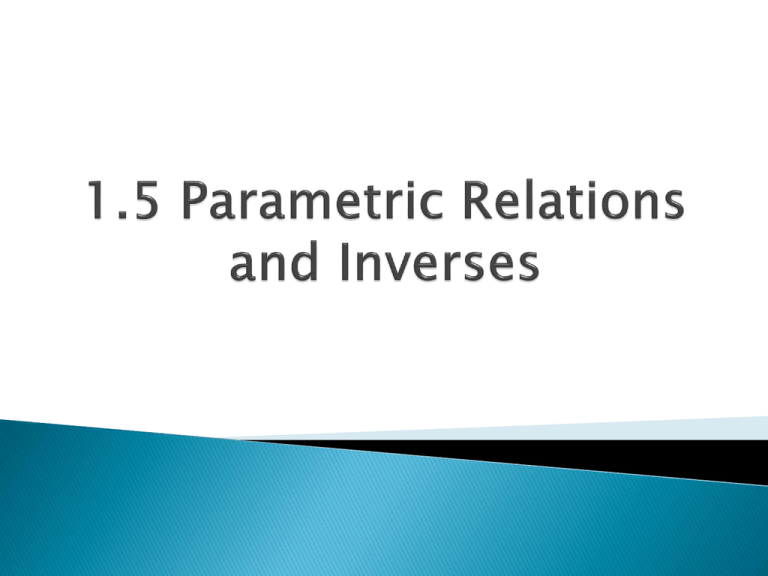parametric and inverse function notes
advertisement

Another natural way to define relations is to define both elements of the ordered pair (x, y), in terms of another variable t, called a parameter Parametric equations: equations in the form x = f(t) and y = g(t) for all t in the interval I. The variable t is the parameter and I .is the parameter interval The set of all ordered pairs (x, y) is defined by the equations x = t + 1 and y = t2 + 2t a. Find the points determined by t =-2, -1, 0, 1, and 2 t x=t+1 y = t2 + 2 t (x, y) -2 -1 0 (-1, 0) -1 0 -1 (0, -1) 0 1 0 (1, 0) 1 2 3 (2, 3) 2 3 8 (3, 8) b. find an algebraic relationship between x and y. (can be called “eliminating the parameter”). Is y a function of x? 1. Solve the x equation for t x = t + 1, so t = x -1 2. Substitute your new equation into the y equation: y = t2 + 2t y = (x – 1)2 + 2(x – 1) now simplify y = x2 – 2x + 1 + 2x – 2 y = x2 - 1 C. graph the relation in the (x, y) plane Mode: arrow down 3, change from FUNC to PAR Hit y = Enter your x and y equations Go to window: tmin: -4, tmax: 2, tstep:.1, xmin: -5, xmax: 5, ymin:-5, ymax:5 Go to 2nd window: have TblStart = 0, indpnt: auto, depend: auto Hit graph Hit 2nd graph to get your table of values find a) find the points determined by t = -3, -2, -1, 0, 1, 2, 3 b) Find the direct algebraic relationship (rewrite the equation in terms of t) c) Graph the relationship (this can be done either by hand or on the calculator) 1. x = 3t and y = t2 + 5 2. x = 5t – 7 and y = 17 – 3t 3. x = |t + 3| and y = 1/t The ordered pair (a, b) is in a relation if and only if the ordered pair (b, a) is in the inverse relation Inverse functions: if f is a one-to-one function with domain D and range R, then the inverse function of f, denoted f-1, is the function with domain R and range D defined by : f-1 (b) = a if and only if f (a) = b Change f(x) to y Switch your x and y Solve for y Rewrite as f-1(x) Determine if f-1(x) is a function Find the inverse of each function 1. f(x) = x/(x + 1) 2. f(x) = 3x – 6 3. f(x) = x - 3 The points (a, b) and (b, a) in the coordinate plane are symmetric with respect to the line y = x. The points (a, b) and (b, a) are reflections of each other across the line y = x. Inverse Composition Rule: a function is oneto-one with inverse function g if and only if: f(g(x)) = x for every x in the domain of g, and g(f(x)) = x for every x in the domain of f Algebraically: use the Inverse Composition Rule, find both f(g(x)) and g(f(x)) and if the answers are the same, the functions are inverses Graphically: in parametric mode, graph and compare the graphs of the 2 sets of parametric equations. p. 126 #5-7 odd, 13-21 odd, 27-31 odd, 34- 36 all






